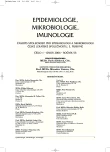-
Medical journals
- Career
Current Epidemiological and Clinical Issues Regarding Helicobacter pylori Infection in Childhood
Authors: J. Sýkora; P. Pazdiora 1; J. Varvařovská; R. Pomahačová; F. Stožický; K. Siala
Authors‘ workplace: Dětská klinika FN a LF UK v Plzni ; Ústav epidemiologie LF UK v Plzni 1
Published in: Epidemiol. Mikrobiol. Imunol. 55, 2006, č. 1, s. 3-16
Overview
H. pylori infection is common worldwide, and is acquired primarily during childhood. The mechanism of acquisition is not clear. In recent years the main focus of interest has been on the transmission of infection from family members to children. The main risk factor for acquiring the infection seems to be low socioeconomic status. H. pylori is associated with gastritis, duodenal ulcers, MALT lymphoma, and gastric adenocarcinoma. Extra-intestinal clinical manifestations have also been reported. However, the infection is often asymptomatic in children and the role of H. pylori infection in gastric manifestations is the subject of conflicting reports. Methods for the diagnosis of H. pylori infection in children are subdivided into invasive and noninvasive. There is a lack of consensus on treatment. The treatment of H. pylori is hampered by high macrolide-resistance. Treatment with proton pump-based triple therapy for 1–2 weeks gives the best eradication rates when combined with supplements containing probiotics. Multinational, multicentre studies in childhood are essential to extend current knowledge to avoid long-term gastroduodenal disease sequelae.
Key words:
Helicobacter pylori – childhood – epidemiology – clinical manifestations – diagnostics – therapy.
Labels
Hygiene and epidemiology Medical virology Clinical microbiology
Article was published inEpidemiology, Microbiology, Immunology

2006 Issue 1-
All articles in this issue
- Current Epidemiological and Clinical Issues Regarding Helicobacter pylori Infection in Childhood
- Current Prevalence of Toxocariasis and other Intestinal Parasitoses among Dogs in Bratislava
- Methods for Detection of Biofilm Formation in Routine Microbiological Practice
- Vibrio Cholerae 01 in a Fish Aquarium
- Diagnosis of Rotavirus Infections in 2004, Major Characteristics in 1998–2004 in the Czech Republic
- Comparison of Efficacy of the Rapid Mycobacteria Growth Indicator Tube (MGIT) Culture Method (Manual System) and Conventional Culture Method in Mycobacterial Detection
- Epidemiology, Microbiology, Immunology
- Journal archive
- Current issue
- Online only
- About the journal
Most read in this issue- Methods for Detection of Biofilm Formation in Routine Microbiological Practice
- Comparison of Efficacy of the Rapid Mycobacteria Growth Indicator Tube (MGIT) Culture Method (Manual System) and Conventional Culture Method in Mycobacterial Detection
- Current Prevalence of Toxocariasis and other Intestinal Parasitoses among Dogs in Bratislava
- Current Epidemiological and Clinical Issues Regarding Helicobacter pylori Infection in Childhood
Login#ADS_BOTTOM_SCRIPTS#Forgotten passwordEnter the email address that you registered with. We will send you instructions on how to set a new password.
- Career

